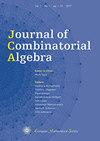Density of random subsets and applications to group theory
IF 0.8
2区 数学
Q3 MATHEMATICS
引用次数: 3
Abstract
Developing an idea of M. Gromov in [5] 9.A, we study the intersection formula for random subsets with density. The density of a subset A in a finite set E is defined by densA := log|E|(|A|). The aim of this article is to give a precise meaning of Gromov’s intersection formula: "Random subsets" A and B of a finite set E satisfy dens(A∩B) = densA+densB−1. As an application, we exhibit a phase transition phenomenon for random presentations of groups at density λ/2 for any 0 < λ < 1, characterizing the C(λ)-small cancellation condition. We also improve an important result of random groups by G. Arzhantseva and A. Ol’shanskii in [2] from density 0 to density 0 ≤ d < 1 120m2 ln(2m) .随机子集的密度及其在群论中的应用
发展了M.Gromov在[5]9.A中的思想,我们研究了具有密度的随机子集的交集公式。有限集合E中子集a的密度由densA:=log|E|(|a|)定义。本文的目的是给出Gromov交集公式的一个精确含义:有限集E的“随机子集”a和B满足dens(a≠B)=densA+densB−1。作为一个应用,我们展示了密度为λ/2的群在任何0<λ<1时的随机呈现的相变现象,表征了C(λ)-小消去条件。我们还改进了G.Arzhantseva和A.Ol’shanskii在[2]中随机分组的一个重要结果,从密度0到密度0≤d<1 120m2 ln(2m)。
本文章由计算机程序翻译,如有差异,请以英文原文为准。
求助全文
约1分钟内获得全文
求助全文

 求助内容:
求助内容: 应助结果提醒方式:
应助结果提醒方式:


